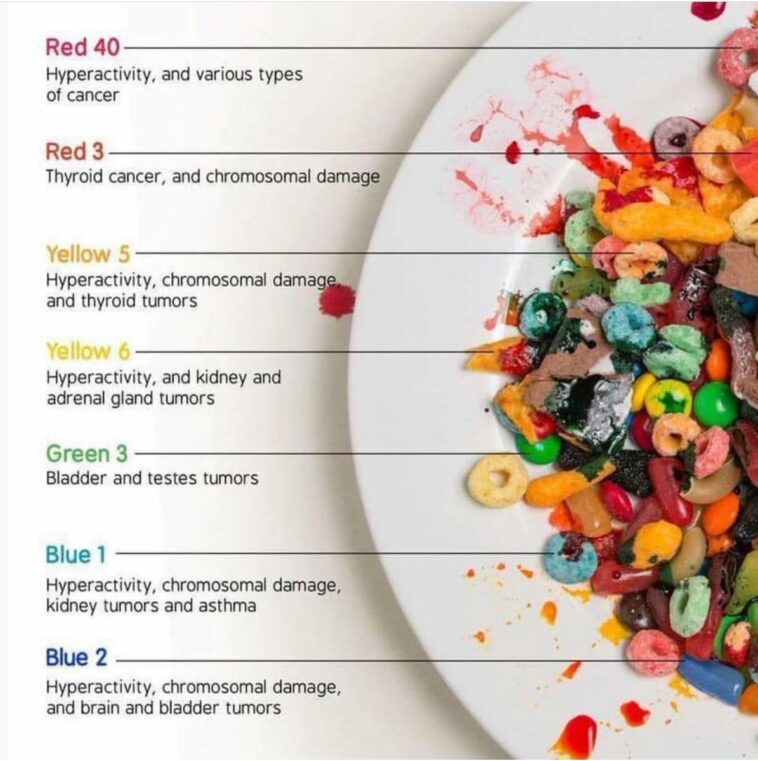Products such as sweets, breakfast cereals, snack foods, and fizzy drinks may soon sport a less visually appealing hue, if U.S. Health and Human Services Secretary Robert F. Kennedy Jr. accomplishes his mission. Kennedy is spearheading a campaign to gradually eliminate synthetic food dyes from the U.S food system, owing to mounting apprehensions regarding their potential health risks.
Food dyes such as Red 40, Yellow 5, and Blue 1, commonly seen on the ingredients list of day-to-day items—ranging from cereal boxes to beverage cans—are under the spotlight. Despite their ubiquitous presence in the U.S market, these synthetic colorants are either prohibited or have usage restrictions in Europe due to health-related worries.
A research published by the California Environment Protection Agency in 2021 revealed a link between artificial food dyes and neurobehavioral problems such as hyperactivity in children. Further researches also hint at the possibility of certain dyes acting as potential carcinogens in animals, thereby sparking added concern about their extensive usage.
This contrast in behavior towards food dye usage between Europe and the U.S is largely attributed to the divergence in food regulation approaches followed by each region. The Institute of Food Technologists elaborates that the FDA has subjected only about 40% of the approximated 6,000 food additive safety adjudications passed over a span of 20 years to direct scrutiny.
The other 60% of these decisions were green-lit by the food manufacturers or industry associations exploiting a legal escape route termed ‘Generally Recognized as Safe’ (GRAS)—this designation circumvents the need for a formal FDA evaluation. This effectively means that a food additive that’s classified as GRAS does not require thorough vetting by the FDA, presenting a serious loophole in the regulatory framework.
On the contrary, the European Union adheres to more stringent norms, permitting only around 411 food additives, starkly contrasted with the nearly 10,000 additives allowed in the U.S. As expected, this push towards restricting colorants has not been unopposed by the food manufacturers.
An advisory document from the Consumer Brands Association cautions that the removal of artificial dyes could inflate production costs, lower consumer appeal, and create potential hurdles in food distribution. The National Confectioners Association also underscores that such changes would render food products ‘significantly more expensive and less accessible.’ Moreover, resorting to natural color substitutes could potentially escalate manufacturing expenses by nearly 10%.
However, the FDA seems determined in its path to introduce changes. In the first month of the year, the FDA declared that Red Dye No. 3 would be banned from food items, starting 2027. Prior to this, it was prohibited in beauty products due to concerns relating to cancer.
Additionally, states such as California have already enacted legislation that bars particular dyes from being incorporated in school meal preparations. In the latest development, the FDA Commissioner validated that the agency plans to collaborate with industry veterans to gradually phase out all petroleum-based synthetic dyes from the U.S. market.
Nevertheless, it’s pertinent to mention that this shift would be a gradual process and would require sufficient time for complete implementation. The FDA is advocating the food companies to replace synthetic colorants derived from petroleum with natural substitutes.
This push aligns with the practices already adopted by these companies for products destined for Europe and Canada, where regulations compel food makers to opt for natural ingredients over artificial dyes, especially in food products intended for consumption by children.
While it’s clear that this transition will not be without its challenges, the potential public health benefits argue strongly in favor of this shift. Only time will tell if these changes will become standard practice in the US food industry and whether they will have the positive impact on public health they aim to achieve.
More so, this situation underscores the crucial need for an ongoing dialogue between government bodies, industry leaders, and researchers to ensure that food safety and consumer health always remain paramount. It’s a delicate balance between cost, appeal, accessibility and health safety – one that will need tight oversight and careful consideration.

